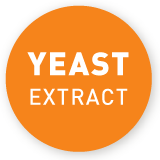In media coverage there is sometimes the accusation that yeast extract is a kind of “hidden flavour enhancer”. But just what function does yeast extract have in food production? The EURASYP newsletter asked the expert Prof. Dr.-Ing. Achim Stiebing, Head of the Institute for Food Technology, North-Rhine Westphalia, Germany at the University of Applied Sciences Ostwestfalen-Lippe, Vice-president of the German Agricultural Society (Deutsche Landwirtschafts-Gesellschaft DLG) and member of the board of trustees of the German Consumer Foundation (Stiftung Warentest).
Yeast extract is criticised as an ingredient because it contains the amino acid glutamate. How do you assess the use of yeast extract in food production?
Yeast extract contains the macronutrients proteins and carbohydrates and furthermore the micronutrients vitamins and minerals. The proportion of glutamate is usually low – below five per cent. Yeast extract is a natural ingredient and not an additive. I see many advantages of using yeast extract in food production – also speaking as a consumer – since the taste inherent to savoury products can be balanced with the optimal dose.
Which ingredients introduce natural glutamate into food products?
Glutamate is the sodium salt of glutamic acid. Glutamic acid occurs naturally in numerous foodstuffs –also in unprocessed foods. So glutamic acid is contained in meat, fish and milk products, but also in some vegetables. Especially high concentrations can be found in Parmesan cheese and soy sauce that are popular condiments used in the kitchen when preparing meals.
How does natural glutamate basically affect the taste of foods? What effect is achieved?
If glutamate is used as an isolated pure substance, then it is deemed an additive and must be included in the list of ingredients. This enhances the characteristic flavour of dishes.
The taste “umami” can be translated as “meaty”, “savoury” or “tasty” and is also provided by natural glutamic acid. Umami is now counted among the five recognized basic tastes alongside sweet, sour, salty and bitter. Natural glutamate has a taste-accentuating effect that, by the way, also makes it possible to reduce the salt content in foods without having to accept noticeable sensory impairments.
Does the food producing industry aim to achieve a particularly high glutamate percentage when developing recipes and adding ingredients such as yeast extract?
Yeast extract is not used as a tactical move, but as a condiment. The dosages are different depending on the desired effect: The added amounts are very small to round off a taste, whereas, if you wish to achieve a bouillon impression, for example in vegetarian dishes, it will be much higher. However, the myth that glutamate can make up for inferior quality in industrially produced foods is simply false.



